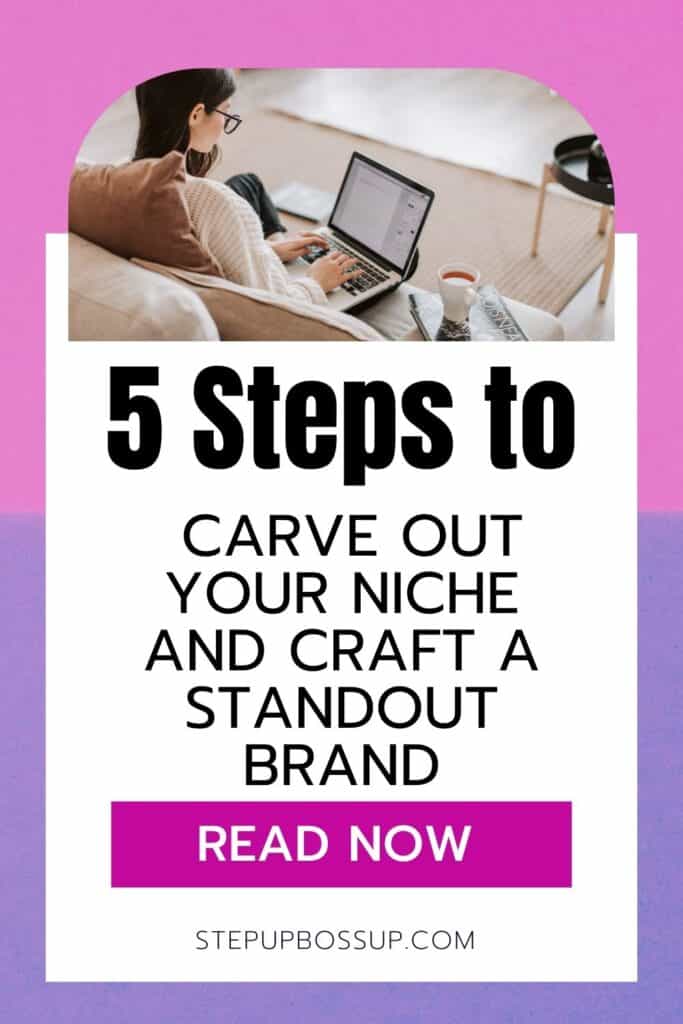Sharing is caring!
In today’s saturated market, making your business stand out is more crucial than ever.
Businesses face the colossal challenge of not only standing out but also resonating with their target audience. The key to success lies in precisely carving out a niche and crafting a brand that’s both unique and memorable. This blog post promises to be your guide in achieving that.
In this article, you will learn:
- How to effectively identify your unique business niche.
- Strategies to develop a distinctive and unforgettable brand.
- Techniques to maintain and evolve your brand, ensuring long-term relevance.
Let’s start on a journey to transform your business identity into a standout brand that captures attention and loyalty.
5 Steps to Carve Out Your Niche
Step 1: Identifying Your Unique Business Niche
Finding your niche is like discovering a secret pathway in a crowded marketplace – it allows your business to travel a less congested, more focused route towards success.
Identifying this niche is not just about pinpointing an untapped market; it’s about aligning your business strengths with specific market needs that are yet to be fully addressed.
Understanding Market Needs and Gaps
To identify your niche, start by conducting a thorough market analysis. This involves:
- Researching Industry Trends: Stay informed about the latest developments in your industry. Look for emerging patterns or areas that are gaining attention but are not yet fully exploited.
- Analysing Competitors: Understand what your competitors are doing, but more importantly, identify what they are not doing. The gaps in their offerings can indicate opportunities for you to fill.
- Listening to Customer Feedback: Pay close attention to customer reviews, feedback, and discussions within your industry. Customers often express unmet needs or frustrations that can reveal niche opportunities.
Aligning with Your Strengths
After understanding the market, align these insights with what you do best. Ask yourself:
- What unique skills or knowledge do I possess?
- How can I leverage my strengths to meet specific market needs?
- What unique perspectives or approaches can I bring to the industry?
The intersection of your strengths and market gaps is where your niche resides. By focusing on an area that capitalises on your unique skills and addresses a specific market need, you can create a distinctive place for your business in the competitive landscape.
Step 2: Understanding Your Target Audience
Knowing who you’re speaking to is as important as knowing what you’re speaking about. Understanding your target audience is a pivotal step in crafting a brand that not only stands out but also deeply connects with the people you aim to serve.
Researching and Defining Your Audience
To gain a deep understanding of your audience, you need to go beyond basic demographics.
Consider the following approaches:
- Conduct Surveys and Interviews: Direct interaction with potential customers can provide valuable insights into their needs, preferences, and pain points.
- Use Social Media Analytics: Platforms like Facebook, Instagram, and LinkedIn offer detailed analytics that can help you understand your audience’s interests, behaviours, and online activities.
- Create Buyer Personas: Develop detailed profiles of your ideal customers. Include their age, occupation, interests, challenges, and goals. This helps in visualising and empathising with your audience on a personal level.
Aligning Brand Messaging with Audience Needs
Once you understand your audience, tailor your brand’s messaging to their specific needs and aspirations. Consider:
- Tone of Voice: Should your brand communicate in a formal, authoritative tone, or a casual, friendly manner? This depends on the preferences of your audience.
- Content Relevance: Ensure that your content addresses the topics that matter most to your audience. Whether it’s through blog posts, videos, or social media, your content should resonate with their interests and needs.
- Engagement Strategies: Identify the channels where your audience is most active and the types of interactions they prefer. Do they engage more with informative articles, interactive polls, or visual content like infographics?
By understanding your audience at a deeper level, you can create a brand experience that is not just seen but felt. This emotional connection is key in transforming casual observers into loyal customers and brand advocates.

Step 3: Developing Your Unique Value Proposition
Crafting a compelling Unique Value Proposition (UVP) is like crafting a key that unlocks the potential of your brand. It’s a clear statement that describes the benefit of your offer, how you solve your customers’ needs, and what distinguishes you from the competition.
Creating a Distinctive UVP
To formulate a powerful UVP, consider the following elements:
- Solve a Real Problem: Your UVP should clearly state how your product or service solves a specific problem that your target audience faces.
- Highlight Unique Benefits: What can customers only get from you? Identify the aspects of your product or service that set you apart from your competitors.
- Be Clear and Concise: A great UVP is easy to understand and memorable. Avoid jargon and keep it straightforward, focusing on the value you deliver.
Examples and Tips for Crafting an Effective UVP
- Example 1: If you’re a fitness app, instead of just saying “Get fit,” a more effective UVP might be, “Personalised fitness plans at your fingertips for busy lifestyles.”
- Example 2: For an eco-friendly clothing line, instead of “Sustainable fashion,” a more impactful UVP could be, “Wear the change: Eco-friendly fashion that empowers local artisans.”
Testing and Refining Your UVP
Once you’ve developed your UVP, test it out:
- Get Feedback: Share your UVP with potential customers, peers, and mentors to get their impressions and feedback.
- A/B Testing: If possible, conduct A/B testing on your website or in your marketing materials to see which version of your UVP resonates more with your audience.
- Iterate and Evolve: Your UVP is not set in stone. As your business grows and market trends shift, be prepared to refine your UVP to stay relevant and compelling.
A strong UVP not only communicates the essence of your brand but also forms an emotional connection with your audience, encouraging them to choose you over your competitors.
Step 4: Designing Your Brand Aesthetics
The visual identity of your brand is a powerful communication tool. It’s more than just a logo or colour scheme; it’s about creating a visual language that conveys your brand’s personality, values, and promises at a glance.
Choosing the Right Visual Elements
When designing your brand’s aesthetics, consider the following key elements:
- Logo Design: Your logo should be simple, memorable, and reflective of your brand’s essence. Whether it’s abstract or literal, ensure it’s versatile and scalable to work across various platforms.
- Colour Scheme: Colours evoke emotions and convey messages. Choose colours that align with the feelings you want your brand to evoke. For instance, blue often conveys trust and dependability, while green is associated with growth and health.
- Typography: The fonts you choose play a crucial role in readability and brand perception. Opt for fonts that are easy to read and consistent with your brand’s character.
Reflecting Your Brand’s Personality
Your brand’s visual identity should be a reflection of its personality. Ask yourself:
- What adjectives describe my brand? (e.g., innovative, professional, playful)
- How can my design choices convey these attributes?
- Are my design elements consistent across all platforms? Consistency in design reinforces brand recognition.
Keeping Your Brand Aesthetics Updated
Staying contemporary is crucial. Keep an eye on design trends and be open to refreshing your visuals to stay relevant. However, any changes should be evolutionary, not revolutionary, to maintain brand recognition.
By thoughtfully designing your brand aesthetics, you create an instant visual connection with your audience. This connection is the first step in building brand recognition, preference, and loyalty.
Step 5: Communicating Your Brand Consistently
Consistent brand communication is the glue that holds your branding efforts together. It’s not just about what you say, but how, where, and when you say it. Consistency in your messaging across all platforms solidifies your brand identity and builds trust with your audience.
Strategies for Consistent Brand Messaging
To maintain consistency in your brand communication, consider the following strategies:
- Unified Brand Voice: Develop a brand voice that reflects your brand’s personality. Whether it’s authoritative, playful, or inspirational, this voice should be evident in all your communications, from website copy to social media posts.
- Content Consistency: Ensure that the content you produce, whether it’s blog posts, videos, or social media updates, aligns with your brand’s values and message. This helps in reinforcing your brand identity.
- Channel Integration: Your brand should be presented cohesively across all channels. This includes your website, social media, email marketing, and even offline marketing materials.
Importance of Adaptability in Communication
While consistency is key, adaptability should not be overlooked. Be prepared to:
- Evolve with Audience Preferences: As your audience grows and changes, be ready to adjust your messaging to stay relevant.
- Respond to Market Changes: Be agile in your communication strategy to respond effectively to industry changes or competitive dynamics.
Measuring the Effectiveness of Your Communication
Regularly assess the impact of your brand communication:
- Feedback and Engagement: Monitor how your audience reacts to and engages with your brand across different platforms.
- Brand Perception Surveys: Conduct surveys to understand how your brand is perceived by your audience and if it aligns with your intended brand identity.
Effective brand communication is an ongoing process. By consistently conveying your brand’s message and adapting to changing dynamics, you’ll build a lasting relationship with your audience, turning them into loyal customers and brand advocates.
Conclusion
In our journey through “5 Steps to Carve Out Your Niche and Craft a Standout Brand,” we’ve navigated the crucial steps necessary to establish a unique and memorable presence in a crowded market.
By identifying a unique business niche, understanding your target audience, developing a compelling unique value proposition, designing resonant brand aesthetics, and communicating your brand consistently, you set the foundation for a brand that not only stands out but also endures.
- We began by identifying your unique business niche, emphasising the importance of aligning your strengths with market gaps.
- Understanding your target audience came next, where we learned to tailor our brand to resonate deeply with our consumers.
- Crafting an impactful unique value proposition was our third step, focusing on differentiating your brand in the marketplace.
- We then explored the creative aspect of designing your brand aesthetics, ensuring visual alignment with your brand’s personality.
- Finally, consistent brand communication was highlighted as the key to maintaining and strengthening your brand’s presence and connection with your audience.
As you start on refining or reinventing your brand, remember that branding is a dynamic process. It’s about continuous evolution and responsiveness to market changes and audience needs.
What’s next? To further your journey, consider exploring advanced strategies in digital marketing and brand storytelling. Delve into how you can leverage digital platforms and compelling narratives to elevate your brand’s reach and impact in an ever-evolving digital landscape.



